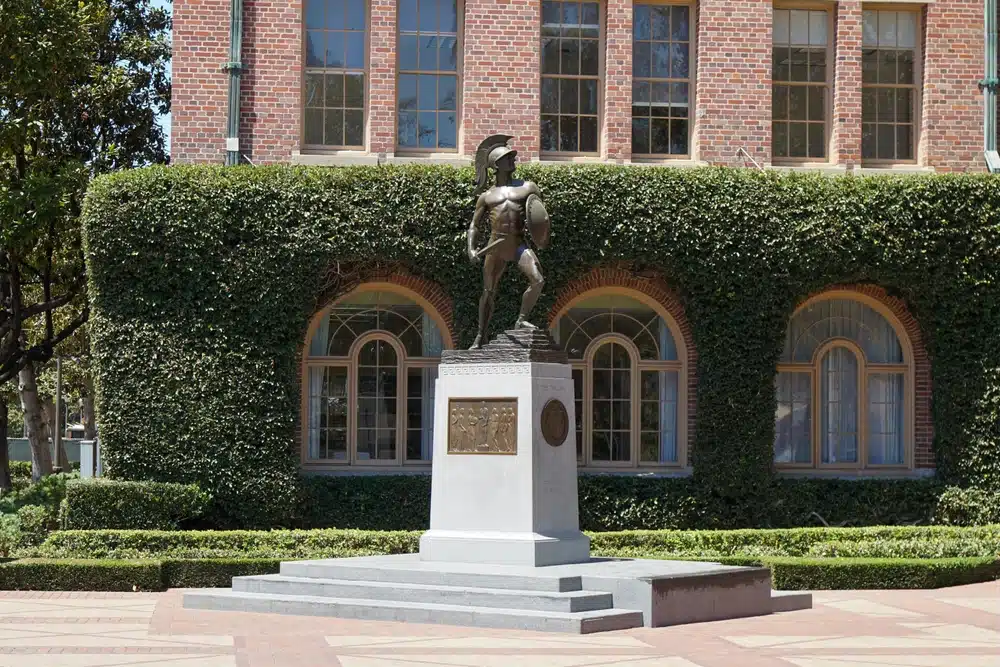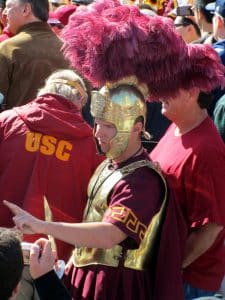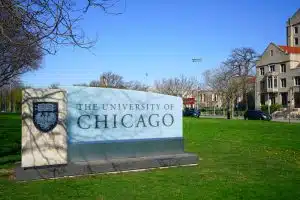Understanding the USC Yield Rate
In the world of college admissions, yield rate is a central factor that guides both students and administrators in their decision-making processes. This article dives deep into the USC yield rate, unraveling its definition, its significance, and how it compares to the yield rates of other universities.
Defining Yield Rate in College Admissions
The yield rate is a significant statistic in higher learning institutions. But what exactly is it?
In the simplest terms, the yield rate is the percentage of admitted students who choose to enroll in a particular institution. It draws a clear line between the number of acceptances an institution offers and the number of students who ultimately decide to attend.
This seemingly simple percentage carries significant weight and is a telling indicator of a college or university’s popularity and desirability among students. By analyzing an institution’s yield rate, one can gain insights into how competitive the school is perceived by its applicants.
When considering the yield rate, it is important to understand the factors influencing a student’s decision to enroll. These factors can range from the institution’s academic reputation and available programs to the campus culture and location. Students often carefully evaluate these aspects before making their final decision.
The Role of Yield Rate in University Rankings
University rankings, often used by prospective students to select their choice institutions, are greatly influenced by yield rates. Given that a high yield rate is indicative of a university’s popularity among its admitted students, it is factored into these rankings.
As such, universities with high yield rates are often more likely to rank high in national and international rankings, further boosting their popularity and desirability among prospective students.
It is worth noting that while yield rate is a significant factor in university rankings, it is not the sole determinant. Other factors such as academic excellence, faculty quality, research opportunities, and student satisfaction also play a crucial role in determining a university’s overall ranking.
How Yield Rate Impacts College Admissions
Yield rate has a direct impact on the college admissions process. Universities must estimate their yield rates as accurately as possible when offering admission.
If the yield rate is overestimated, a university might confront an instance with more students than available resources. An underestimate, on the other hand, leads to a situation where dorms and classes are under-filled, which could result in financial losses.
To attract a higher yield rate, colleges and universities often employ various strategies. These may include personalized communication with admitted students, hosting campus visit events, offering financial aid packages, and showcasing the unique opportunities available at their institution.
By actively engaging with admitted students, institutions aim to increase their chances of securing a higher yield rate.
Furthermore, a high yield rate can have a positive impact on a college’s reputation and financial stability. It signals to prospective students, parents, and donors that the institution is highly sought after and provides a quality education.
In conclusion, the yield rate is a crucial metric that reflects an institution’s appeal to admitted students. It influences university rankings and directly impacts the college admissions process. By understanding and effectively managing yield rates, colleges and universities can enhance their reputation, attract top talent, and ensure long-term success.
The Specifics of the USC Yield Rate
The above metrics apply to every higher learning institution, including the University of Southern California. However, every university has its unique yield rate shaped by various internal and external factors.
Historical Trends in the USC Yield Rate
Historically, USC has showcased an exceptional and steady yield rate. This can be attributed to the university’s optimal location in Los Angeles, its diverse range of programs, and the quality of academic offerings.
The university’s long-standing reputation for excellence has consistently attracted a high number of admitted students.
Over the last decade, the average USC yield rate has been 36.82%. However, the Class of 2027 boasts an impressive yield rate of 44.89 percent. This marks a notable increase compared to the previous year when USC had a yield rate of 41.2%, resulting in the enrollment of 3,420 students.
Throughout the years, the USC yield rate has weathered external factors, such as economic recessions and global pandemics.
Despite these challenges, the university’s strong appeal and commitment to providing a top-notch education have remained steadfast. This resilience is a testament to USC’s ability to adapt and maintain its position as a desirable choice for prospective students.
Factors Influencing the USC Yield Rate
Several factors contribute to USC’s impressive yield rate. Most notably, USC offers a rich and varied student life that goes beyond the classroom.
The university’s robust athletic programming allows students to engage in competitive sports and showcase their talents. Additionally, cultural festivals and campus traditions create a vibrant and inclusive community that fosters a sense of belonging for students.
Moreover, USC’s commitment to excellence in education and research plays a significant role in attracting students. The university’s faculty members are renowned experts in their respective fields, offering students unparalleled learning experiences.
USC’s emphasis on cutting-edge research and innovation further enhances its appeal, as students have the opportunity to contribute to groundbreaking discoveries and advancements.
Furthermore, USC’s location in Los Angeles, a global hub for various industries, provides students with unique opportunities for internships, networking, and career development.
The university’s strong connections with industry leaders and alumni networks offer students a competitive edge in their chosen fields.
In conclusion, USC’s impressive yield rate is a result of its exceptional academic offerings, vibrant student life, commitment to excellence, and advantageous location. These factors, combined with the university’s resilience in the face of challenges, make USC a highly sought-after institution among admitted students.
Comparing USC’s Yield Rate to Other Universities
A comparison of USC’s yield rate with other universities can provide deeper insights into its standing in the world of higher education.
When analyzing the USC yield rate, it is important to consider how it compares to Ivy League schools. The Ivy League institutions, known for their prestigious reputation and limited acceptance rates, often have relatively higher yield rates.
| Ivy League Institution | Yield Rate |
| Princeton University | 76.66% |
| Brown University | 63.25% |
| Yale University | 69.97% |
| Columbia University | 64.07% |
| Dartmouth College | 67.41% |
| Harvard University | 84% |
| University of Pennsylvania | 69.66% |
However, USC manages to hold its ground well in this comparison. Despite not being part of the Ivy League, the USC yield rate remains competitive, which is a testament to its growing reputation and commitment to providing a high-quality education.
Public universities, although they may have larger student populations, sometimes struggle to match the personalized attention and resources available at a private institution like USC. This is one factor that contributes to USC’s higher yield rate.
Students are attracted to the individualized support and opportunities for growth that USC offers, which ultimately leads to a higher percentage of admitted students choosing to enroll.
It is worth noting that USC’s success in maintaining a competitive yield rate is not solely dependent on its reputation or resources. The university’s commitment to fostering a vibrant and inclusive campus community also plays a significant role.
USC’s dedication to creating a supportive environment where students feel valued and empowered contributes to a higher yield rate as prospective students recognize the positive impact it can have on their overall college experience.
In conclusion, USC’s yield rate stands strong compared to Ivy League schools and public universities. Its ability to attract and retain a high percentage of admitted students is a testament to its growing reputation, commitment to providing personalized attention, and dedication to creating a vibrant campus community.
As USC continues to evolve and innovate in the field of higher education, its yield rate will likely remain a key indicator of its success and desirability among prospective students.
The Implications of the USC Yield Rate
The USC yield rate USC carries certain implications for both the university and prospective students.
When analyzing the implications of USC’s yield rate, it is important to consider what this rate says about the university’s popularity and how it affects future applicants.
What USC’s Yield Rate Says About Its Popularity
A high yield rate indicates that USC is a popular choice among students who have been offered admission. This speaks volumes about USC’s reputation as a leading institution providing a desirable student experience, both in terms of academics and campus life.
The high yield rate suggests that USC has successfully established itself as a top-tier university, attracting many talented and motivated students.
It reflects the university’s ability to offer a comprehensive educational experience that meets the needs and aspirations of prospective students.
Furthermore, the popularity of USC can also be attributed to its strong alumni network and connections in various industries. The university’s reputation for producing successful graduates who go on to make significant contributions in their respective fields adds to its allure.
Additionally, USC’s location in Los Angeles, a vibrant and culturally diverse city, enhances its appeal. The proximity to numerous internship and job opportunities, as well as a thriving arts and entertainment scene, makes USC an attractive choice for students seeking a well-rounded college experience.
How the USC Yield Rate Affects Future Applicants
For future applicants, the yield rate of USC can serve as a critical piece of information. High yield rates suggest that admitted students find USC an attractive option, indicating stiff competition and high standards of admission. Thus, prospective students can gauge their chances and form realistic expectations when applying.
However, it is important to note that a high yield rate does not necessarily mean that USC is the right fit for every applicant. Each student has unique preferences and goals, and it is essential for them to thoroughly research and consider all aspects of the university before making a decision.
Furthermore, the yield rate can also impact the university’s admissions strategy. A high yield rate may prompt USC to become more selective in the admissions process, as they can anticipate a higher percentage of admitted students accepting their offers.
This, in turn, may lead to increased competition among applicants and a more rigorous evaluation of their qualifications.
On the other hand, a lower yield rate may prompt the university to reevaluate its recruitment and marketing strategies to attract a larger pool of qualified applicants. USC may focus on highlighting unique programs, scholarships, and opportunities that set it apart from other institutions in order to increase its appeal and yield rate.
In conclusion, the USC yield rate serves as a reflection of its popularity and reputation among prospective students. It provides valuable insights for future applicants, allowing them to assess their chances of admission and make informed decisions. Additionally, the yield rate can influence the university’s admissions strategy, shaping the composition of future incoming classes.
Strategies to Improve the USC Yield Rate
Like all universities aiming for continuous improvement, USC also seeks to increase its yield rate. Here are some strategies that could help.
Enhancing Campus Life to Attract Students
A vibrant campus life is a key factor when students decide on their choice of institution. By hosting more events that facilitate student participation, providing additional clubs and societies, and maintaining a robust sports program, USC can make itself more appealing to prospective students, thus increasing its yield rate.
Furthermore, USC can create more opportunities for students to showcase their talents and interests. By organizing talent shows, art exhibitions, and cultural festivals, the university can provide a platform for students to express themselves and foster a sense of belonging.
These events not only attract prospective students but also create a strong sense of community among current students, leading to higher retention rates.
Strengthening Academic Programs to Boost Yield Rate
USC’s academic programs can be enhanced by leveraging current technological breakthroughs and innovative teaching methods, and targeting globally relevant research areas.
Strengthening academic offerings in this way not only boosts the institution’s reputation but also makes it more attractive to academically oriented students, thereby improving yield rates.
Imagine being a student at USC, where cutting-edge technology is integrated into every aspect of your education. Professors utilize virtual reality simulations to bring complex concepts to life, making learning engaging and interactive.
The university invests in state-of-the-art research facilities, attracting leading scholars and researchers worldwide. Students have the opportunity to collaborate with these experts, contributing to groundbreaking discoveries and innovations.
Moreover, USC can expand its academic programs to include emerging fields that are in high demand. By offering courses in artificial intelligence, data science, and sustainable development, the university can attract passionate students about these areas of study.
USC’s commitment to staying at the forefront of knowledge and innovation will undoubtedly appeal to ambitious and forward-thinking students, increasing the yield rate.
In conclusion, enhancing campus life and strengthening academic programs can significantly improve the USC yield rate. A vibrant and inclusive community, coupled with cutting-edge academic offerings, will attract prospective students and create a strong sense of loyalty among current students.
USC’s commitment to continuous improvement ensures that it remains a top choice for students seeking a transformative educational experience.
The USC yield rate demonstrates its appeal and the growing interest of prospective students. The university’s consistent commitment to maintaining low acceptance rates and high yield rates signifies a competitive and academically driven environment.
As applicants aspire to become a part of this esteemed institution, they often face a daunting and highly selective admissions process. This is where AdmissionSight comes into play, providing invaluable guidance and support to students throughout the application journey.
With expert insights, personalized strategies, and a wealth of experience in navigating the complexities of USC’s admissions process, AdmissionSight can be a valuable resource for those looking to make their dreams of attending the University of Southern California a reality.








































